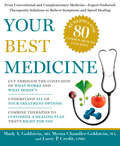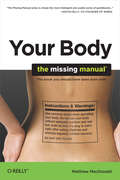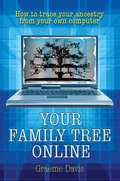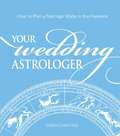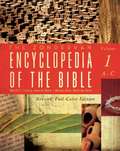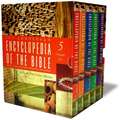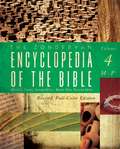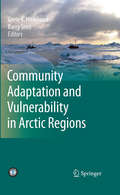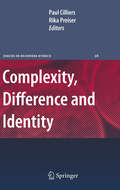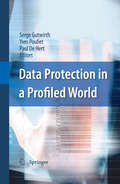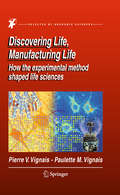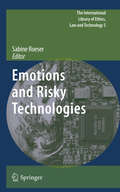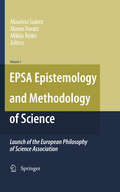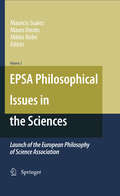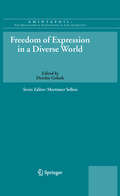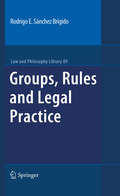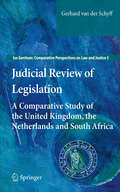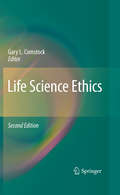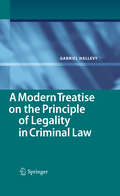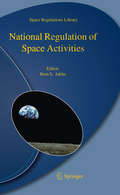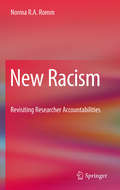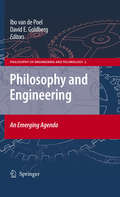- Table View
- List View
Your Best Medicine: From Conventional and Complementary Medicine--Expert-Endorsed Therapeutic Soluti ons to Relieve Symptoms and Speed Healing
by Mark A. Goldstein Myrna Chandler Goldstein Larry P. CreditIntegrative medicine—the practice of combining remedies from various therapeutic disciplines to optimize relief and speed healing—is transforming both how health professionals treat disease and how patients manage their own care. Your Best Medicine introduces the reader to this new world of healing options for everyday ailments like dry skin, fatigue, and indigestion as well as more serious conditions like diabetes, heart disease, and obesity. All of the treatments and techniques in Your Best Medicine have been handpicked by two practitioners—one a conventionally trained MD, the other a specialist in complementary therapies—based on established therapeutic protocols, research evidence, and clinical experience. Conventional and complementary remedies appear side by side so readers can evaluate at a glance the remedies' relative effectiveness, safety, and ease of use. Every entry in Your Best Medicine also provides important information on risk factors, symptoms, and diagnostic techniques, as well as preventive measures. Armed with this knowledge, readers can make decisions wisely and confidently at every stage of their care.
Your Body: The Missing Manual
by Matthew MacdonaldWhat, exactly, do you know about your body? Do you know how your immune system works? Or what your pancreas does? Or the myriad -- and often simple -- ways you can improve the way your body functions? This full-color, visually rich guide answers these questions and more. Matthew MacDonald, noted author of Your Brain: The Missing Manual, takes you on a fascinating tour of your body from the outside in, beginning with your skin and progressing to your vital organs. You'll look at the quirks, curiosities, and shortcomings we've all learned to live with, and pick up just enough biology to understand how your body works. You'll learn: That you shed skin more frequently than snakes do Why the number of fat cells you have rarely changes, no matter how much you diet or exercise -- they simply get bigger or smaller How you can measure and control fat That your hair is made from the same stuff as horses' hooves That you use only a small amount of the oxygen you inhale Why blood pressure is a more important health measure than heart rate -- with four ways to lower dangerously high blood pressure Why our bodies crave foods that make us fat How to use heart rate to shape an optimal workout session -- one that's neither too easy nor too strenuous Why a tongue with just half a dozen taste buds can identify thousands of flavors Why bacteria in your gut outnumbers cells in your body -- and what function they serve Why we age, and why we can't turn back the clock What happens to your body in the minutes after you die Rather than dumbed-down self-help or dense medical text, Your Body: The Missing Manual is entertaining and packed with information you can use. It's a book that may well change your life.Reader comments for Your Brain: The Missing Manual, also by author Matthew MacDonald: "Popular books on the brain are often minefields of attractive but inaccurate information. This one manages to avoid most of the hype and easy faulty generalizations while providing easy to read and digest information about the brain. It has useful tricks without the breathless hype of many popular books." -- Elizabeth Zwicky, The Usenix Magazine "...a unique guide that should be sought after by any who want to maximize what they can accomplish with their mental abilities and resources." -- James A. Cox, The Midwest Book Review - Wisconsin Bookwatch "If you can't figure out how to use your brain after reading this guide, you may want to return your brain for another." -- The Sacramento Book Review, Volume 1, Issue 2, Page 19 "It's rare to find a book on any technical subject that is as well written and readable as Your Brain: The Missing Manual. The book covers pretty much anything you may want to know about your brain, from what makes it up, through how it develops to how to mitigate the affects of aging. The book is easy reading, fact packed and highlighted notes and practical applications. So if you want to learn more about your brain, how it works, how to get the best out of it or just want to stave off the ravages of Alzheimers (see chapter ten for details of how learning helps maintain your brain) then I can't recommend this book highly enough." -- Neil Davis, Amazon.co.uk "MacDonald's writing style is perfect for this kind of guide. It remains educational without becoming overly technical or using unexplained jargon. And even though the book covers a broad scope of topics, MacDonald keeps it well organized and easy to follow. The book captures your attention with fun facts and interesting studies that any person could apply to their own understanding of human ability. It has great descriptions of the brain and its interconnected parts, as well as providing full color pictures and diagrams to offer a better explanation of what the author is talking about." -- Janica Unruh, Blogcritics Magazine
Your Family Tree Online: How To Trace Your Ancestry From Your Own Computer
by Graeme DavisThis is a step-by-step guide to using the wealth of online records to trace your family tree from your own computer, without the need to travel to national and regional record offices. Whether you are a novice or an experienced genealogist, and whether you plan to devote just a few hours of your time or embark on a life-time hobby, this book will guide you through the mass of records available - birth, marriage and death, the census, and much, much more - so that you can trace your line back hundreds of years. You will also learn how to upload your results to the internet, both to preserve your family's heritage and to connect with relatives, so that you can exchange photos and reminiscences.Contents: Welcome!; 1. What the internet offers the genealogist; 2. How to start; 3. Finding records of birth, marriage and death; 4. Using census records; 5. Other major sources; 6. Military; 7. Wills and where to find them online; 8. Migration; 9. Newspapers; 10. Occupations; 11. The poor and workhouse records; 12. Noble ancestors; 13. Directories; 14. School and university records; 15. Working with the wider context; 16. Family medical history; 17. DNA; 18. Working with names; 19. Recording your family tree; 20. Online recording options; 21. Problems of online trees; 22. Finding living relatives; 23. Genealogical miscellany; 24. Accent and dialect; 25. Final; Key websites; Index
Your Family Tree Online: How to Trace Your Ancestry From Your Own Computer
by Dr Graeme DavisThis is a step-by-step guide to using the wealth of online records to trace your family tree from your own computer, without the need to travel to national and regional record offices. Whether you are a novice or an experienced genealogist, and whether you plan to devote just a few hours of your time or embark on a life-time hobby, this book will guide you through the mass of records available - birth, marriage and death, the census, and much, much more - so that you can trace your line back hundreds of years. You will also learn how to upload your results to the internet, both to preserve your family's heritage and to connect with relatives, so that you can exchange photos and reminiscences.Contents: Welcome!; 1. What the internet offers the genealogist; 2. How to start; 3. Finding records of birth, marriage and death; 4. Using census records; 5. Other major sources; 6. Military; 7. Wills and where to find them online; 8. Migration; 9. Newspapers; 10. Occupations; 11. The poor and workhouse records; 12. Noble ancestors; 13. Directories; 14. School and university records; 15. Working with the wider context; 16. Family medical history; 17. DNA; 18. Working with names; 19. Recording your family tree; 20. Online recording options; 21. Problems of online trees; 22. Finding living relatives; 23. Genealogical miscellany; 24. Accent and dialect; 25. Final; Key websites; Index
Your Wedding Astrologer
by Karen ChristinoEvery bride needs a little help when planning her dream wedding. This book helps the bride plan a wedding suited to her astrological sign. Based on the traits of her zodiac sign, every bride-to-be will find ideal suggestions for the best dates for the big day, beautiful wedding and bridesmaids' dresses and colors, romantic honeymoon destinations, and how to avoid negative influences like Mercury or Venus in retrograde. Experienced astrologer Karen Christino also provides insights into communicating with grooms of each sign and how to maximize the potential for a happy, lifelong marriage. With this book, every wedding is created in the stars!
Your Wedding Astrologer
by Karen ChristinoEvery bride needs a little help when planning her dream wedding. This book helps the bride plan a wedding suited to her astrological sign. Based on the traits of her zodiac sign, every bride-to-be will find ideal suggestions for the best dates for the big day, beautiful wedding and bridesmaids? dresses and colors, romantic honeymoon destinations, and how to avoid negative influences like Mercury or Venus in retrograde. Experienced astrologer Karen Christino also provides insights into communicating with grooms of each sign and how to maximize the potential for a happy, lifelong marriage. With this book, every wedding is created in the stars!
The Zondervan Encyclopedia of the Bible, Volume 1: Revised Full-Color Edition
by Merrill C. Tenney Moisés SilvaRevised edition. Volume 1 of 5. The Zondervan Encyclopedia of the Bible has been a classic Bible study resource for more than thirty years. Now thoroughly revised, this new five-volume edition provides up-to-date entries based on the latest scholarship. Beautiful full-color pictures supplement the text, which includes many new articles in addition to thorough updates and improvements of existing topics. Different viewpoints of scholarship permit a well-rounded perspective on significant issues relating to doctrines, themes, and biblical interpretation. The goal remains the same: to provide pastors, teachers, students, and devoted Bible readers with a comprehensive and reliable library of information. • More than 5,000 pages of vital information on Bible lands and people • More than 7,500 articles alphabetically arranged for easy reference • Hundreds of colorful maps, illustrations, charts, and graphs • Scholarly articles ranging across the entire spectrum of theological and biblical topics, backed by the most current body of archaeological research • Over 250 contributors from around the world • Introductions to each book of the Bible • Bibliographies and helpful cross-references
The Zondervan Encyclopedia of the Bible, Volume 2: Revised Full-Color Edition
by Moisés Silva Merrill C. TenneyRevised edition. Volume 2 of 5. The Zondervan Encyclopedia of the Bible has been a classic Bible study resource for more than thirty years. Now thoroughly revised, this new five-volume edition provides up-to-date entries based on the latest scholarship. Beautiful full-color pictures supplement the text, which includes new articles in addition to thorough updates and improvements of existing topics. Different viewpoints of scholarship permit a wellrounded perspective on significant issues relating to doctrines, themes, and biblical interpretation. The goal remains the same: to provide pastors, teachers, students, and devoted Bible readers a comprehensive and reliable library of information. • More than 5,000 pages of vital information on Bible lands and people • More than 7,500 articles alphabetically arranged for easy reference • Hundreds of full-color and black-and-white illustrations, charts, and graphs • 32 pages of full-color maps and hundreds of black-and-white outline maps for ready reference • Scholarly articles ranging across the entire spectrum of theological and biblical topics, backed by the most current body of archaeological research • 238 contributors from around the world
The Zondervan Encyclopedia of the Bible, Volume 3: Revised Full-Color Edition
by Moisés Silva Merrill C. TenneyRevised edition. Volume 3 of 5. The Zondervan Encyclopedia of the Bible has been a classic Bible study resource for more than thirty years. Now thoroughly revised, this new five-volume edition provides up-to-date entries based on the latest scholarship. Beautiful full-color pictures supplement the text, which includes new articles in addition to thorough updates and improvements of existing topics. Different viewpoints of scholarship permit a wellrounded perspective on significant issues relating to doctrines, themes, and biblical interpretation. The goal remains the same: to provide pastors, teachers, students, and devoted Bible readers a comprehensive and reliable library of information. • More than 5,000 pages of vital information on Bible lands and people • More than 7,500 articles alphabetically arranged for easy reference • Hundreds of full-color and black-and-white illustrations, charts, and graphs • 32 pages of full-color maps and hundreds of black-and-white outline maps for ready reference • Scholarly articles ranging across the entire spectrum of theological and biblical topics, backed by the most current body of archaeological research • 238 contributors from around the world
The Zondervan Encyclopedia of the Bible, Volume 4: Revised Full-Color Edition
by Merrill C. Tenney Moisés SilvaRevised edition. Volume 4 of 5. The Zondervan Encyclopedia of the Bible has been a classic Bible study resource for more than thirty years. Now thoroughly revised, this new five-volume edition provides up-to-date entries based on the latest scholarship. Beautiful full-color pictures supplement the text, which includes new articles in addition to thorough updates and improvements of existing topics. Different viewpoints of scholarship permit a wellrounded perspective on significant issues relating to doctrines, themes, and biblical interpretation. The goal remains the same: to provide pastors, teachers, students, and devoted Bible readers a comprehensive and reliable library of information. • More than 5,000 pages of vital information on Bible lands and people • More than 7,500 articles alphabetically arranged for easy reference • Hundreds of full-color and black-and-white illustrations, charts, and graphs • 32 pages of full-color maps and hundreds of black-and-white outline maps for ready reference • Scholarly articles ranging across the entire spectrum of theological and biblical topics, backed by the most current body of archaeological research • 238 contributors from around the world
Community Adaptation and Vulnerability in Arctic Regions: Framework Document For An International Polar Year Consortium
by Barry Smit Grete K. HovelsrudUnder the auspices of International Polar Year (IPY), the CAVIAR consortium was formed with partners from all eight Arctic countries. The aim of the interdisciplinary CAVIAR project is to increase understanding of the vulnerability of Arctic communities to changing environmental conditions, including climate change, and to contribute to the development of adaptive strategies and policies. In partnership with local collaborators in over two dozen communities, researchers have documented the conditions and forces that contribute to vulnerabilities, identified adaptive strategies and attempted to assess the prospects for adaptation in the future.
Complexity, Difference and Identity: An Ethical Perspective (Issues in Business Ethics #26)
by Rika Preiser Paul Cilliers"Complexity" has been part of the academic discourse for a decade or two. Texts on Complexity fall mainly in two categories: fairly technical and mathematical on the one hand, and fairly broad, vague and general on the other. Paul Cilliers' book Complexity and Postmodernism. Understanding Complex Systems (Routledge 1998) constituted an attempt to bridge this divide by reflecting more rigorously on the philosophical implications of complexity, and by making it accessible to the social sciences. This edited volume is a continuation of this project, with specific reference to the ethical implications of acknowledging complexity. These issues are pertinent to our understanding of organisations and institutions and could contribute significantly to the development of a richer understanding of ethics in business and would be a useful tool for teachers, researchers and post-graduate students with ethical concerns in disciplines ranging from Philosophy, Applied Ethics, Sociology, Organisational Studies, Political Science, Anthropology and Cultural Studies. The central theme which binds all the contributions together is: the inevitability of normative and ethical issues when dealing with complex phenomena. The book should thus be useful in the development of Business Ethics on two levels: in the first place on the level of developing a strong theoretical foundation, in the second place in providing specific examples of this theory in action in the real world.
Data Protection in a Profiled World
by Paul De Hert Yves Poullet Serge GutwirthOne of the most challenging issues facing our current information society is the accelerating accumulation of data trails in transactional and communication systems, which may be used not only to profile the behaviour of individuals for commercial, marketing and law enforcement purposes, but also to locate and follow things and actions. Data mining, convergence, interoperability, ever- increasing computer capacities and the extreme miniaturisation of the hardware are all elements which contribute to a major contemporary challenge: the profiled world. This interdisciplinary volume offers twenty contributions that delve deeper into some of the complex but urgent questions that this profiled world addresses to data protection and privacy. The chapters of this volume were all presented at the second Conference on Privacy and Data Protection (CPDP2009) held in Brussels in January 2009 (www.cpdpconferences.org). The yearly CPDP conferences aim to become Europe's most important meeting where academics, practitioners, policy-makers and activists come together to exchange ideas and discuss emerging issues in information technology, privacy and data protection and law. This volume reflects the richness of the conference, containing chapters by leading lawyers, policymakers, computer, technology assessment and social scientists. The chapters cover generic themes such as the evolution of a new generation of data protection laws and the constitutionalisation of data protection and more specific issues like security breaches, unsolicited adjustments, social networks, surveillance and electronic voting. This book not only offers a very close and timely look on the state of data protection and privacy in our profiled world, but it also explores and invents ways to make sure this world remains a world we want to live in.
Discovering Life, Manufacturing Life
by Paulette M. Vignais Pierre V. VignaisThis book tells the story of how thinkers, over time, have dared to explore using experimental devices and how the experimental method established itself and took a predominant role in the life sciences. While life sciences continue to advance and knowledge becomes more widespread and accessible, philosophers now focus on problems of ethics particularly with respect to the reproductive functions that contemporary biology is able to manipulate and modify. Looking at the stunning progress made by scientific thought over the last five centuries we might ask ourselves what were the triggering factors that lead to the experimental method. How did this logical and objective approach to the exploration of various enigmas in nature arise and spread at a particular moment in time in the western world? Was there an influence from the social, religious or political context? Was the energy of a few individuals sufficient to initiate such a revolution? The authors of this book take us on journey of the mind, from the ancient roots of scientific rationality to today's irresistible trend in genetic manipulation, particularly focused on human beings. Inevitably this will lead the reader to view the way in which science is done today under a new light. A fascinating discussion, based on concrete examples and experiments, provides food for thought, not only with respect to the experimental method itself, but also regarding the organization of science as it exists today and how it is perceived.
Emotions and Risky Technologies
by Sabine RoeserBy offering an original and challenging approach to the topic of risk and emotion, this book covers new territory. It focuses on risk and emotion from the perspective of moral philosophy and emphasizes that emotions are an important source of moral knowledge.
EPSA Epistemology and Methodology of Science
by Mauro Dorato Mauricio Suárez Miklós RédeiThese volumes collect a selection of papers presented at the Founding Conference of the European Philosophy of Science Association meeting in Madrid. The volumes provide an excellent overview of the state of the art in philosophy of science as practised nowadays in different European countries.
EPSA Philosophical Issues in the Sciences
by Mauro Dorato Mauricio Suárez Miklós RédeiThese volumes collect a selection of papers presented at the Founding Conference of the European Philosophy of Science Association meeting in Madrid. The volumes provide an excellent overview of the state of the art in philosophy of science as practised nowadays in different European countries.
Freedom of Expression in a Diverse World
by Deirdre GolashThe debate over the foundations and boundaries of freedom of speech, once a matter of balancing the individual rights of unpopular speakers against broader social interests, took on a new shape in the 1980s when feminists began to advocate restrictions on pornography and critical race theorists to advocate restriction of certain kinds of hate speech. These challenges to traditional liberalism brought into sharp focus the issues of why we value free speech and how much weight it should be given against competing values. Difficult as it is to resolve these issues domestically, we now face new challenges arising from the increasingly rapid dissemination of information across international borders in an atmosphere of considerable political tension. The riots in response to the publication of Danish cartoons ridiculing Mohammed and the death threats against Salman Rushdie indicate how dramatically the stakes have been raised. At the same time, there is increased concern over discriminatory treatment of sexual minorities, Muslims, and immigrants. Against this background, the essays in this volume seek to illuminate why we value freedom of speech and expression and how this freedom can be weighed against other values, such as multicultural sensitivity, the rights of racial and sexual minorities, and the prevention of violence, both domestically and internationally.
Groups, Rules and Legal Practice
by Rodrigo Eduardo Sánchez BrigidoEver since Hart´s The Concept of Law, legal philosophers agree that the practice of law-applying officials is a fundamental aspect of law. Yet there is a huge disagreement on the nature of this practice. Is it a conventional practice? Is it like the practice that takes place, more generally, when there is a social rule in a group? Does it share the nature of collective intentional action? The book explores the main responses to these questions, and claims that they fail on two main counts: current theories do not explain officials´ beliefs that they are under a duty qua members of an institution, and they do not explain officials´ disagreement about the content of these institutional duties. Based on a particular theory of collective action, the author elaborates then an account of certain institutions, and claims that the practice is an institutional practice of sorts. This would explain officials´ beliefs in institutional duties, and officials´ disagreement about those duties. The book should be of interest to legal philosophers, but also to those concerned with group and social action theories and, more generally, with the nature of institutions.
Judicial Review of Legislation
by Gerhard van der SchyffConstitutionalism is the permanent quest to control state power, of which the judicial review of legislation is a prime example. Although the judicial review of legislation is increasingly common in modern societies, it is not a finished project. This device still raises questions as to whether judicial review is justified, and how it may be structured. Yet, judicial review's justification and its scope are seldom addressed in the same study, thereby making for an inconvenient divorce of these two related avenues of study. To narrow the divide, the object of this work is quite straightforward. Namely, is the idea of judicial review defensible, and what influences its design and scope? This book addresses these matters by comparing the judicial review of legislation in the United Kingdom (the Human Rights Act of 1998), the Netherlands (the Halsema Proposal of 2002) and the Constitution of South Africa of 1996. These systems present valuable material to study the issues raised by judicial review. The Netherlands is of particular interest as its Constitution still prohibits the constitutional review of acts of parliament, while allowing treaty review of such acts. The Halsema Proposal wants to even out this difference by allowing the courts also to apply constitutional norms to legislation and not only to international norms. The Human Rights Act and the South African Constitution also present interesting questions that will make their study worthwhile. One can think of the issue of dialogue between the legislature and the judiciary. This topic enjoys increased attention in the United Kingdom but is somewhat underexplored in South African thought on judicial review. These and similar issues are studied in each of the three systems, to not only gain a better understanding of the systems as such, but also of judicial review in general.
Life Science Ethics
by Gary L. ComstockDoes nature have intrinsic value? Should we be doing more to save wilderness and ocean ecosystems? What are our duties to future generations of humans? Do animals have rights? This revised edition of "Life Science Ethics" introduces these questions using narrative case studies on genetically modified foods, use of animals in research, nanotechnology, and global climate change, and then explores them in detail using essays written by nationally-recognized experts in the ethics field. Part I introduces ethics, the relationship of religion to ethics, how we assess ethical arguments, and a method ethicists use to reason about ethical theories. Part II demonstrates the relevance of ethical reasoning to the environment, land, farms, food, biotechnology, genetically modified foods, animals in agriculture and research, climate change, and nanotechnology. Part III presents case studies for the topics found in Part II.
A Modern Treatise on the Principle of Legality in Criminal Law
by Gabriel HallevyThis book discusses legality, one of the four main principles of criminal law, and is divided into six parts, according to the scientific understanding of this key concept. Chapter 1 explores the relation between legality and the general theory of criminal law in the context of the structure and development of legality in human society. This chapter also outlines the four secondary principles of legality and describes them in general terms. Chapters 2-5 discuss in detail each of the four secondary principles (Legitimate Sources of the Criminal Norm; Applicability of the Criminal Norm in Time; Applicability of the Criminal Norm in Place; and Interpretation of the Criminal Norm). Finally, Chapter 6 rounds out the discussion by addressing the problem of the conflict of laws.
National Regulation of Space Activities
by Ram S. JakhuThis book comprehensively addresses all aspects of national space laws and regulations governing the conduct of space activities in fifteen space-faring nations. This is the first book of its kind that contains a compilation of materials written from a neutral and objective perspective by the world's leading space law experts selectively drawn from the fifteen countries whose laws and regulations are covered by the book. In order to provide the reader with a full understanding and appreciation of the various relevant national laws and regulations that govern space activities, this book explores the policies and rationales underlying the law, constitutional basis for the adoption of national space laws, some facts about national space activities in the respective countries, and as well, discusses the relevant principles and rules of international space law in order to bring to light the international context of the national laws described. Since the U.S. presently has the most developed and extensive regime of national space laws and regulations, six chapters of this book are devoted to a thorough examination of those laws and regulations. The unique feature of this compilation is that, apart from the description of applicable national laws and regulations on space activities that it provides, it also sets out the various procedures to be followed particularly by domestic and foreign private entities in order to achieve compliance with the numerous and varied national legal requirements concerning space activities. This work will be a valuable resource not only to students, researchers and academics in the fields of space law and regulation, but also to space industry executives, specialist lawyers, foreign ministries as well as international organizations, such as the United Nations.
New Racism
by Norma RommThis book develops a debate around responsible social inquiry into new racism. A variety of ways of researching new forms of racism (for example, aversive, modern, cultural, purportedly color-blind, and new racism) are addressed. Experiments that have been undertaken to inquire into group identity and people's implicit bias in relation to those perceived as "other" are critically explored and their potential consequences reconsidered. The book also critically explores survey research, which, it is argued, can serve to reinforce the notion of the existence of ethnoracial groups with defined boundaries that inhere in social life. The book considers interviewing (including focus group interviewing) and case study research (including participant observation/ethnography) in terms of possibilities for moving beyond new forms of racism. Action research (defined by the understanding of an inextricable link between knowing and acting) is examined in-depth in terms of the hopes to "make a difference" at the moment of inquiry. Types of retroductive logic that are used to examine underlying structures that arguably unduly constrain people's life chances and render human relationships inhumane are also explored. The book draws together the different arguments; and it proposes ways in which the design of research into new racism can better approached as well as ways in which dialogue around processes of inquiry and the products thereof can be better fostered. Suggestions for nurturing humane social relationships that provide for transcultural meaning-making are threaded through the text.
Philosophy and Engineering: An Emerging Agenda
by Ibo van de Poel David E. GoldbergWhereas science, technology, and medicine have all called forth dedicated philosophical investigations, a fourth major contributor to the technoscientific world in which we all live - that is, engineering - has been accorded almost none of the philosophical attention it deserves. This volume thus offers a first characterisation of this important new field, by some of the primary philosophers and ethicists interested in engineering and leading engineers interested in philosophical reflections. The volume deals with such questions as: What is engineering? In what respect does engineering differ from science? What ethical problems does engineering raise? By what ethical principles are engineers guided? How do engineers themselves conceive of their profession? What do they see as the main philosophical challenges confronting them in the 21st century? The authors respond to these and other questions from philosophical and engineering view points and so illustrate how together they can meet the challenges and realize the opportunities present in the necessary encounters between philosophy and engineering - encounters that are ever more important in an increasingly engineered world and its problematic futures.
